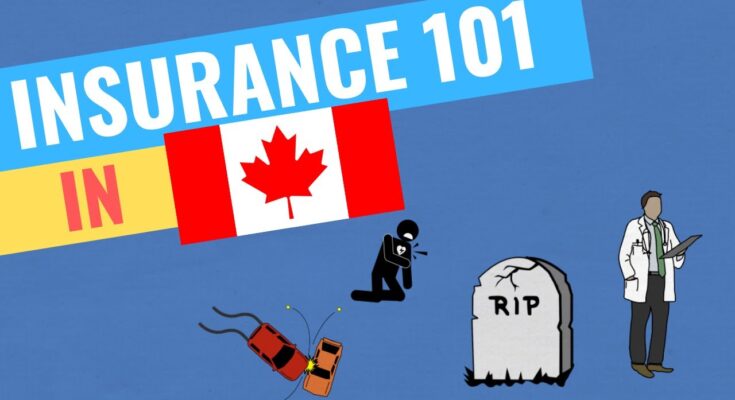Introduction to Insurance in Canada
Insurance in Canada serves as a crucial financial safety net, protecting individuals, families, and businesses from unforeseen risks and financial burdens. The Canadian insurance sector is robust, regulated primarily at the provincial level, with oversight ensuring fair practices and consumer protection. Insurance policies span across various categories, providing coverage for different aspects of life and enterprise.
In Canada, individuals rely on both private and government-provided insurance. The majority of citizens have access to health coverage through the publicly funded healthcare system, while private insurance addresses gaps or enhances coverage. Other essential types include auto, home, life, and business insurance.
Canada’s diverse insurance market features offerings from domestic insurers and global companies.
Types of Insurance Available in Canada
Canada offers various types of insurance to meet the diverse needs of its residents. These options are tailored to provide financial protection in different scenarios:
- Health Insurance: While public healthcare covers many services, private insurance helps with dental, vision, prescriptions, and extended care.
- Life Insurance: Covers financial support for dependents in the event of the policyholder’s passing, available as term or whole life policies.
- Auto Insurance: Mandatory for vehicle owners, providing coverage for accidents, liability, and damages.
- Home Insurance: Protects property and belongings against risks like fire, theft, or natural disasters.
- Travel Insurance: Covers medical expenses and trip interruptions during international or domestic travel.
- Business Insurance: Tailored to protect business assets, liability, and operations.
Auto Insurance: Requirements and Coverage
Auto insurance is mandatory in Canada for all vehicle owners. Each province and territory governs its own auto insurance regulations, specifying the minimum required coverage. Typically, the minimum covers third-party liability, accident benefits, and uninsured motorist protection.
The required third-party liability coverage generally protects against claims for injury, death, or property damage caused by the insured vehicle. Accident benefits provide compensation for medical expenses, loss of income, and rehabilitation costs following an accident, regardless of fault.
Optional coverages, such as collision or comprehensive insurance, are available to cover damages to the policyholder’s vehicle. Policy terms, premiums, and requirements can vary depending on location and provider.
Home Insurance: What You Need to Know
Home insurance in Canada offers financial protection for homeowners against unforeseen circumstances like property damage, theft, or liability. Policies are designed to cover repair or replacement costs for structures, personal belongings, and legal responsibilities related to the property.
Coverage Types
- Dwelling Coverage: Protects the structure of the home, including walls, roof, and foundation.
- Personal Property Coverage: Covers personal belongings, such as furniture and electronics, whether inside or outside the house.
- Liability Protection: Protects the homeowner against claims from third parties for injuries or property damage linked to the property.
- Additional Living Expenses (ALE): Covers temporary housing costs if the property becomes uninhabitable.
Factors Influencing Premiums
- Location and property value
- Deductibles chosen by the homeowner
- Age and condition of the house
- Security features such as alarms
Comparing policies and understanding exclusions is essential for adequate coverage.
Life Insurance: Understanding Your Options
Life insurance provides financial security for loved ones in the event of the policyholder’s death. In Canada, several types of life insurance are available, each catering to different needs and financial goals.
- Term Life Insurance: Offers coverage for a specified period, typically ranging from 10 to 30 years. It is often more affordable and suitable for temporary needs, such as mortgage protection or income replacement during working years.
- Whole Life Insurance: Provides lifelong coverage and includes a cash value component, which grows over time. Premiums are usually higher but remain consistent throughout the policyholder’s life.
- Universal Life Insurance: Combines death benefits with investment options, allowing policyholders to adjust premiums and death benefits while building savings.
Careful evaluation of financial needs and risk tolerance is essential to choose the right policy type.
Health Insurance: Government vs. Private Plans
Health insurance in Canada is broadly categorized into government-funded and private plans.
- Government-funded plans, such as those provided under the Canada Health Act, cover essential medical services, including hospital care and physician visits. These are primarily funded through taxes and vary by province, affecting coverage levels. Prescription drugs, dental care, and vision services are often excluded from public plans.
- Private health insurance fills the gaps in government coverage. Individuals or employers can purchase these plans, which typically include extended health benefits like dental, vision, and prescription drugs.
Transitioning between plans depends on individual needs, regional policies, and access to employer-sponsored benefits.
Travel Insurance: How to Stay Protected
Travel insurance provides financial protection against unexpected challenges that may arise during trips. It typically covers costs associated with medical emergencies, trip cancellations, lost luggage, and travel delays. Policies may also include coverage for accidental injuries, emergency evacuations, and interruption of travel plans due to natural disasters or unforeseen events.
Travelers should evaluate their specific needs, such as coverage for high-risk activities or pre-existing medical conditions. Some policies offer optional add-ons for extended coverage. It’s vital to read the policy details carefully to understand any exclusions or limitations. Comparing various providers ensures the best value and scope of protection.
Insurance for Businesses: Coverage Options
Businesses in Canada have access to a range of insurance options designed to protect their operations, assets, and employees. Common business insurance policies include:
- Commercial Property Insurance: Covers damage to physical assets such as buildings, equipment, and inventory caused by events like fire, theft, or natural disasters.
- General Liability Insurance: Protects against claims of bodily injury, property damage, or personal injury caused to third parties during business operations.
- Product Liability Insurance: Essential for businesses that manufacture or sell products, covering claims arising from defective or harmful products.
- Professional Liability Insurance (Errors & Omissions): Shields service providers from claims of negligence, errors, or omissions in their professional duties.
- Cyber Liability Insurance: Safeguards businesses from financial losses due to data breaches, cyber-attacks, or other technology-related incidents.
- Business Interruption Insurance: Compensates for income loss during temporary shutdowns caused by covered perils.
Additionally, businesses with employees must comply with mandatory Workers’ Compensation Insurance, governed by provincial laws, to protect employees injured on the job. Specialized coverage options exist for unique industries.
How to Choose the Right Insurance Policy
When choosing an insurance policy in Canada, individuals must consider several key factors to identify the best coverage for their needs.
Evaluate Needs
- Assess the type of insurance required based on circumstances, such as life insurance for financial dependents or auto insurance for vehicle owners.
- Consider risks unique to your lifestyle, location, or profession.
Compare Providers
- Research multiple insurance companies for their reputation, customer service, and claims process.
- Review coverage limits, exclusions, and premium costs.
Understand Policy Terms
- Examine deductibles, coverage levels, and add-ons to ensure the policy aligns with your financial situation.
- Pay attention to the fine print to avoid unexpected exclusions.
Seek Advice
- Consult professional advisors or brokers for personalized guidance.
- Consider recommendations from trusted networks or reviews.
Careful evaluation ensures the policy meets financial and protection goals precisely.
Insurance Claims: The Process and Tips
Filing an insurance claim involves several key steps to ensure timely and accurate processing.
- Notify the Insurance Provider: Policyholders should promptly contact their insurer after an incident to report the claim.
- Document the Incident: Gathering evidence such as photos, receipts, or police reports is essential for supporting the claim.
- Complete the Claim Form: Filling out and submitting the insurer’s claim form accurately is critical.
- Work with a Claims Adjuster: Insurers may assign an adjuster to assess damage, validate the claim, and estimate costs.
- Receive the Settlement: After approval, compensation is issued based on policy terms.
Tips for Success
- Review policy details to understand coverage limits.
- Communicate clearly and respond to inquiries promptly.
- Keep copies of all claim-related documents for reference.
Emerging Trends in the Canadian Insurance Market
The Canadian insurance sector is evolving with technological advancements and changing consumer preferences. Key trends shaping the market include:
- Digital Transformation: Insurers are increasingly leveraging artificial intelligence and automation for personalized policies, claims processing, and customer service.
- Usage-Based Insurance (UBI): This model, particularly in auto insurance, uses telematics to offer premiums based on driving habits, promoting safer practices.
- Climate-Resilient Coverage: As extreme weather events rise, insurers are developing policies tailored to safeguard against floods, wildfires, and climate-related risks.
- Cyber Insurance Growth: With growing digital threats, more businesses and individuals are seeking comprehensive cyber liability coverage.
- Sustainability Initiatives: Insurers are adopting environmentally-friendly investment strategies and incentivizing policyholders to reduce their carbon footprints.
These trends reflect a dynamic landscape poised to address modern-day risks while capitalizing on innovation.
Overcoming Common Insurance Pitfalls
Navigating insurance policies in Canada requires careful consideration to avoid common mistakes that may lead to unexpected financial burdens. Understanding the fine print is essential; many consumers overlook exclusions and limitations within policy terms. Evaluating coverage regularly can prevent underinsurance, especially as life circumstances change.
Relying solely on price comparisons without analyzing coverage details can result in inadequate protection. Professionals often recommend bundling policies for discounts, but consumers must ensure the bundled package meets their needs. Seeking advice from licensed insurance brokers can clarify complex policies and streamline decision-making. Proactive research and consultation are key strategies to avoid pitfalls effectively.
Conclusion: Making Informed Decisions About Insurance
When evaluating different types of insurance in Canada, individuals should carefully assess their unique needs, risk tolerance, and financial situations. Understanding available options—such as health, auto, life, home, and travel insurance—is critical to ensuring comprehensive protection.
Factors to consider when selecting a policy include:
- Coverage limits and exclusions
- Premium costs and deductible amounts
- Reputation of the insurance provider
- Compliance with provincial regulations
Seeking professional advice from a licensed broker or financial advisor can help clarify complex terms and conditions. Comparing multiple quotes allows consumers to identify the most suitable policies for their circumstances. Ultimately, prudent assessment ensures financial security and peace of mind.

